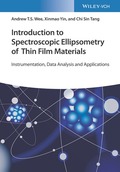Introduction to Spectroscopic Ellipsometry of Thin Film Materials
Instrumentation, Data Analysis and Applications

1. Auflage April 2022
208 Seiten, Softcover
1 Abbildungen (1 Farbabbildungen)
Praktikerbuch
Kurzbeschreibung
Dieses Buch ist eine aktualisierte Einführung in die Anwendung der spektrometrischen Ellipsometrie.
Jetzt kaufen
Preis: 102,00 €
Preis inkl. MwSt, zzgl. Versand
Euro-Preise für Wiley-VCH- und Ernst & Sohn-Titel sind nur für Deutschland gültig. In EU-Ländern gilt die lokale Mehrwertsteuer. Portokosten werden berechnet.
Dieses Buch ist eine aktualisierte Einführung in die Anwendung der spektrometrischen Ellipsometrie mit ihrem praktischen Einsatz bei der Untersuchung von Grenzflächeneigenschaften, Elektronenstrukturen und Quasiteilcheneigenschaften verschiedener Klassen von Dünnschichtmaterialien.
2. Strongly Correlated Systems: Cuprates & Manganites
3. Two-dimensional Transition Metal Dichalcogenides
4. Single layer graphene systems
5. Nickelate Systems
6. Future Development and Applications of Spectroscopic Ellipsometry
Xinmao Yin is Professor of Physics at the Shanghai University, China (from 2021). His research is focused on quantum materials and broad energy range optical spectroscopic techniques. He completed his degrees of the bachelor and PhD in Zhejiang University in 2010 and National University of Singapore in 2014, respectively. His expertise is in the field of condensed matter physics and optical spectroscopy, with primary strength in studying the electronic and spin structures of materials using optical spectroscopic techniques at different energy range. He specializes in studying materials such as 2D transition metal dichalcogenides, High-Tc superconducting cuprates, and colossal magnetoresistance manganites and their interfaces. He is expert in the various optical analysis techniques (ellipsometry, reflectivity, absorption, etc.) and the synchrotron-based spectroscopy (XAS, XMCD, XRD, XPS, ARPES etc.). Using these spectroscopic techniques, the underlying physical mechanism of macroscopic and microscopic properties governing superconductivity, ferromagnetism, phase transition, as well as spin changes, plasma and exciton excitations have been studied.
Chi Sin Tang is scientist at the Institute of Materials Research and Engineering, Agency for Science Technology and Research (A*STAR), Singapore. He holds a Bachelor of Science (Honours) in Physics (2012) as well as a post-graduate diploma in Education from Nanyang Technological University. An expert user of optical techniques such as Spectroscopic Ellipsometry and synchrotron-based spectroscopic measurements that include X-ray Absorption Spectroscopy and Photoemission Spectroscopy, his research interests mainly focus on the electronic and optical properties of low-dimensional materials such as two-dimensional transition metal dichalcogenides, unconventional oxide thin-films and the effects of interfacial interactions.


